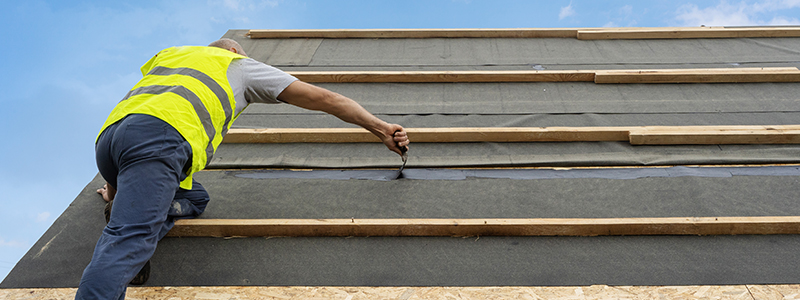Waterproofing steep roofs is essential for protecting your home or building from water damage. Steep roofs present unique challenges due to their angle and the increased risk of water penetration. However, with the right waterproofing solutions, you can ensure the longevity and durability of your roof. In this article, we will explore various waterproofing techniques, materials, and considerations for steep roofs.

Why is waterproofing important for steep roofs?
Steep roofs are more susceptible to water infiltration due to the angle at which they are constructed. Rainwater, snow, and ice can accumulate on the roof, increasing the potential for leaks and water damage. Waterproofing the roof is crucial to prevent water penetration, which can lead to structural damage, mold growth, and costly Repairs.
What are the different waterproofing solutions for steep roofs?
1. Underlayment
One of the most common waterproofing solutions for steep roofs is the use of underlayment. Underlayment acts as a secondary barrier between the roofing material and the roof deck, providing an extra layer of protection against water infiltration. There are several types of underlayment available, including:
- Asphalt-saturated felt: This traditional underlayment is made of organic or synthetic materials saturated with asphalt. It provides excellent water resistance and is commonly used on steep roofs.
- Synthetic underlayment: These are made from polymer materials and offer superior resistance to water and UV rays. They are lightweight and easy to install.
- Rubberized asphalt underlayment: This type of underlayment is self-adhering and provides a watertight seal. It offers excellent waterproofing properties and is suitable for high-risk areas.
2. Roofing membranes
Roofing membranes are another effective waterproofing solution for steep roofs. These membranes are made of synthetic materials, such as PVC or TPO, and offer excellent water resistance. They can be installed directly on the roof deck or on top of the underlayment for added protection. Roofing membranes are available in various thicknesses and can be heat-welded or mechanically fastened.
3. Roof coatings
Roof coatings are liquid or spray-applied waterproofing materials that form a protective barrier on the roof surface. They are commonly used for flat roofs but can also be applied to steep roofs. Roof coatings can be acrylic, silicone, or elastomeric-based, providing flexibility, durability, and UV resistance. They are easy to apply and can extend the lifespan of the roof.
4. Flashing
Flashing is a crucial part of waterproofing steep roofs. It is used to seal joints and transitions, such as chimney stacks, vents, skylights, and dormers. Flashing is typically made of metal, such as copper or aluminum, and is custom-fabricated to fit the specific angles and contours of the roof. Proper installation and sealing of flashing ensure a watertight seal and prevent water infiltration.
5. Gutters and downspouts
While not directly related to waterproofing the roof, the installation of gutters and downspouts is essential for managing water runoff. Steep roofs can generate large amounts of water during rainfall, which, if not properly directed, can cause erosion and damage to the foundation. Gutters and downspouts collect water and channel it away from the roof, protecting it from water-related issues.
What factors should you consider when waterproofing a steep roof?
When selecting a waterproofing solution for your steep roof, several factors should be taken into consideration:
- Roof pitch: The angle of the roof will determine the type of materials that are suitable and the installation method required.
- Climate: The climate plays a significant role in the choice of waterproofing materials. Regions with high rainfall or snowfall may require more robust solutions.
- Budget: Different waterproofing solutions vary in cost. Consider your budget and choose a solution that provides long-term value for money.
- Roofing material: The type of roofing material you have will influence the choice of waterproofing solutions. Some materials may require specific underlayments or coatings.
- Maintenance: Consider the maintenance requirements of the chosen waterproofing solution. Some materials may need periodic inspections or recoating to ensure continued effectiveness.
Frequently Asked Questions
-
Can I use the same waterproofing solution for all steep roofs?
While there are common waterproofing solutions, the choice depends on various factors such as roof pitch, climate, and roofing material. It’s important to assess each roof individually and select the most suitable solution. -
How long does waterproofing for a steep roof last?
The lifespan of the waterproofing solution depends on several factors, including the materials used, installation quality, and maintenance. However, with proper installation and regular inspections, most waterproofing solutions can last for several decades. -
Can I apply a roof coating on an existing roof?
Yes, roof coatings can be applied on existing roofs, provided that the surface is clean, dry, and free of any loose or damaged materials. Proper surface preparation and application techniques are crucial for the coating’s effectiveness and longevity. -
Do I need to hire a professional for waterproofing my steep roof?
While some waterproofing solutions can be DIY-friendly, it is recommended to hire a professional roofing Contractor for steep roofs. They have the expertise, tools, and knowledge to ensure proper installation and effective waterproofing.
Conclusion
Waterproofing steep roofs is essential for protecting your home or building from water damage. By using underlayment, roofing membranes, coatings, flashing, and proper gutter systems, you can ensure a watertight seal and prevent water infiltration. Consider factors such as roof pitch, climate, and budget when selecting a waterproofing solution. Remember to consult with a professional roofing contractor for expert advice and installation. Take proactive measures to preserve the integrity of your steep roof for years to come.
